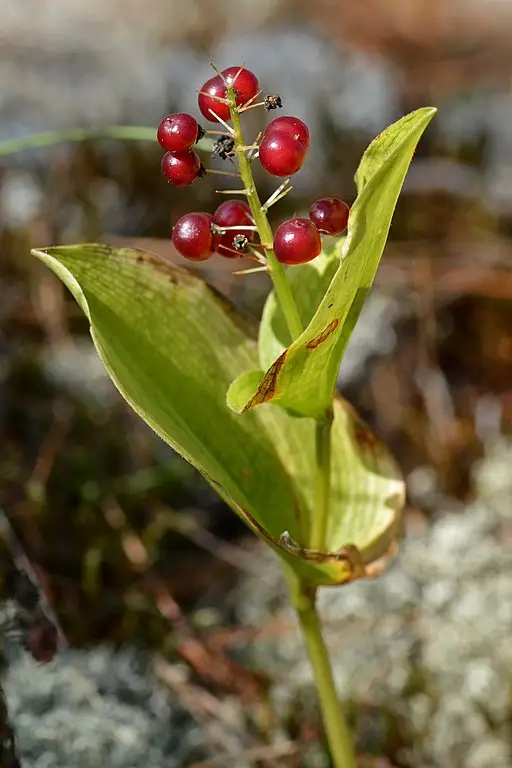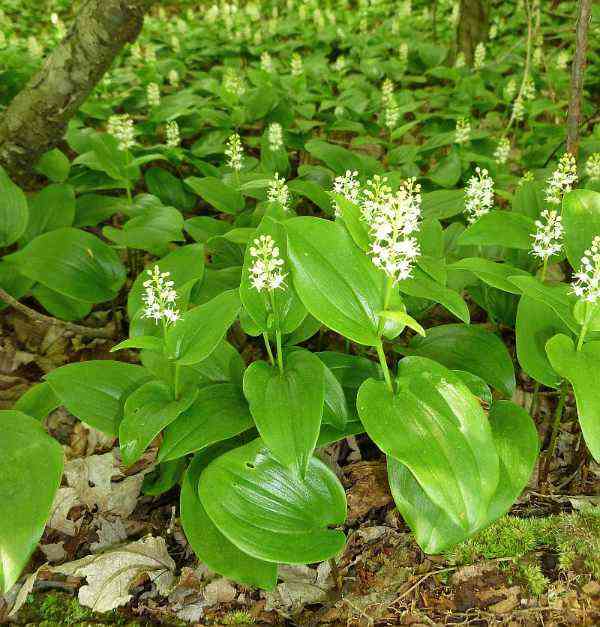Canada Mayflower Growing Guide
Photo:
Joshua Mayer from Madison, WI, USA, CC BY-SA 2.0, via Wikimedia Commons
Canada Mayflower can form large patches in a wide range of habitats, but it is most common in boreal coniferous forests. They are abundant on the forest floor and emerge tightly coiled. It blooms with frothy white flowers in late April.
Its leaves are some of the earliest to appear in the spring. The white flowers bloom in spring, followed by the formation of red berries into the fall. These berries are eaten by birds and small mammals, especially Ruffed Grouse, mice and chipmunks, and are valuable to birds.
Quick Growing Guide
Botanical Name: Maianthemum canadense
Also Called: False Lily-of-the-valley, Wild Lily-of-the-Valley.
En français: Maïanthème du Canada
See More Plants in this Botanical Family:
Blooms:
Sun / Shade:
Watering:
Water: Do not let it dry
The berries are edible but must be eaten in moderation as it has a strong laxative effect.
The plant’s Latin name, Maianthemum, is a combination of the words May and blossom, a nod to when it blooms in different regions of its range. False Lily-of-the-Valley, Wild Lily-of-the-Valley, Two-leaved Solomon’s Seal, Canadian May-lily, and Canada Beadruby are other names for Canada Mayflower. The latter term describes the berries of the plant and their color and shape. In New Jersey and Kentucky, this species is classified as endangered.
Canada Mayflower Appearance
It is a vigorous rhizomatous perennial that can reach a height of 5 to 15 cm. On a thin stem, it has two or three smooth, elongated heart-shaped leaves. The leaves are three inches long (8 cm) and have wavy edges. From late spring to early summer, it has tiny, white, star-shaped blooms (4 mm) in a terminal cluster on thin stalks barely above the leaves.

Photo Credit: Ryan Hodnett, CC BY-SA 4.0 via Wikimedia Commons
In the late summer, they give way to eye-catching, ruby-red berries. Canada Mayflower is a wonderful ground-covering plant for woodland gardens that spreads by underground roots. It would outcompete other, less aggressive forest wildflowers if planted with them.

Habitat
Maianthemum canadense grows in a wide range of soil types. Though is thrives in partial shade, it responds well to a wide range of sunlight intensities. This plant can thrive in both well-drained and poorly-drained soils. Although it is considered a late successional species, it has been discovered in the understory of forest stands of all ages. It takes a long time to recover after a fire.
Plant Care for Maianthemum canadense
Canada Mayflower thrives best in environments like its natural habitat. Sow immediately outside in the late fall for winter. The time it takes for seeds to sprout might range from 30 days to 2 years. If you are direct seeded, kindly name the area you planted and keep it weed-free.
Soil for Canada Mayflower
Canada Mayflower performs best in average, medium moisture, well-drained soils, and partial shade. Grow in neutral to acidic, humus-rich, moist but well-drained soil in complete or partial shade. Heavy shade is acceptable to the plant. Canada Mayflower prefers humus-rich, moist, to slightly dry soils. It cannot tolerate heat or humidity.
Water
If Canada Mayflower is planted in a 5.0″ pot and is not exposed to direct sunlight, it requires 0.8 cups of water every nine days.
Light
Canada Mayflower may struggle to grow and lose leaves in the absence of enough sunlight. To maximize the potential for development, place it less than three feet from a window that faces south.
Uses
Canada Mayflower has a fairly small number of palatable uses. There are no reports of other original American tribes using the plant as food outside the Potawatomi, who are supposed to eat the berries.
Health Benefits
The plant was utilized by several tribes to treat headaches and sore throats. According to legend, the Iroquois treated renal problems with a decoction of the roots.
Ruffed Grouse, Eastern Chipmunks, Canada Jays, and White-footed Mice, eat the translucent red berries to a limited extent. Snowshoe Hares have been observed to eat part of the leaves.







Leave a Reply
You must be logged in to post a comment.